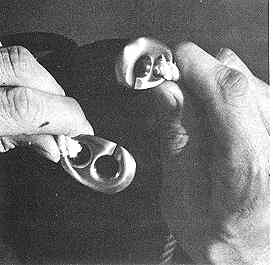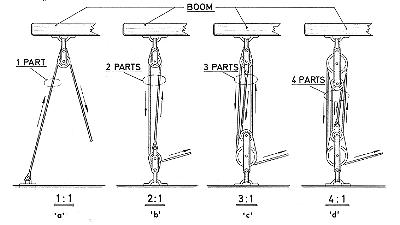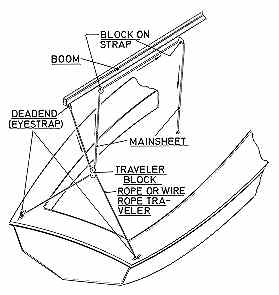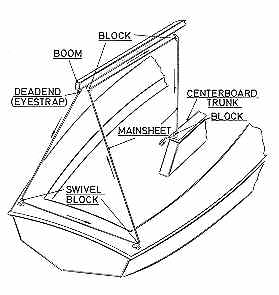Rigging Small Sailboats
Chapter 5
.....running rigging
Page 2Another method used to attach halyards to sails is with BRUMMEL HOOKS (as shown in Fig. 5-2). These are special patented fittings used in pairs which allow quick attachment once you get the hang of using them. The Brummel hooks come in a wide variety of sizes and types which can be used for other situations as well as with halyards. One hook passes through the cringle at the head of the sail, and another goes through the eye at the end of the halyard, or can be merely knotted to the halyard. The two connect with a twist of the wrist.

FIG. 5-2-Brummel hooks are patented fittings used in pairs. They are used to secure lines together or lines to other items such as sails. A twist of the two hooks is all that is required to join or release them. |
SHEETS
The lines used to control the trim or position of the sails are called SHEETS. The line used to control the mainsail is called the MAINSHEET, and the line used to control the jib is called the JIB SHEET. Rope is used for the sheets, and "yacht braid" type is often used because it is easier on the hands and does not kink or jam as easily as twisted rope. Because the force of the wind on the sails is often greater than the strength of the crew, it is often necessary for the sheets to have a built-in "mechanical advantage." This is where the various blocks (or "pulleys") and winches come onto the scene in various configurations to ease the work of the crew.
 |
|
FIG. 5-3 - Various tackle configurations. The power of a tackle depends on the number of "parts" in the tackle. Actually, 'a' is not really a tackle as the block merely changes the direction of the line, thereby affording no gain in power. Fiddle blocks are shown for clarity where two sheaves are used, though double blocks, with side by side sheaves, would give the same result. The arrows show the direction the line will move when pulled. |
|
When the sheets are lead through a system of blocks, a TACKLE is formed that, depending on the number of "parts," will decrease the effort required to do the work. This is called "mechanical advantage" and is shown by Fig. 5-3. All main sheet configurations are nothing more than variations on these basic tackles, even though the location of the various blocks may disguise the number of parts used in the tackle. In figuring a tackle, it is usual to deduct 10% from each "part" per block to allow for the friction caused at the sheave in the block. Also note that the more parts in a tackle, the more line you must have and consequently the more line you will have to pull through the tackle to move the object a comparable distance. Sheet rig types come in an infinite variety of configurations, and some of the more common main and jib sheet rigs have been shown in Figs. 5-4 through 5-13. To run the sheet through the blocks is to REEVE the sheet, and it is a good practice to knot the running end of all sheets so they will not inadvertently pass through and out the blocks, causing loss of control of the sails. |

FIG. 5-4 - Ratio 2:1. A simple mainsheet set-up which uses a rope or wire rope traveler. Although the traveler is shown deadending to eye straps, one end could be made adjustable by belaying to a jam cleat. The mainsheet can be held by hand or a block or cam cleat can be used as shown in Fig. 5-5. |
|
Note that in many cases the mainsheet forms, or is used in conjunction with, the TRAVELER. The traveler lets the mainsheet rig or unit move or "travel" from one side of the boat to the other. Travelers can range from the combination mainsheet/ traveler type, or a simple length of line, or very elaborate fittings complete with tracks using blocks with ball or roller bearings and lines to control them. 
FIG. 5-5 - Ratio 3:1. The mainsheet is used as the traveler in this rig. |